The NVIDIA GeForce RTX 2070 Founders Edition Review: Mid-Range Turing, High-End Price
by Nate Oh on October 16, 2018 9:00 AM ESTPower, Temperature, and Noise
As always, we'll take a look at power, temperature, and noise of the RTX 2070 Founders Edition, especially considering its atypically large GPU, new cooler design, new fixed-function hardware, and higher TDPs. For the most part, the dual axial fan open air design provide straightforward benefits in lower noise and cooling, though with drawbacks as mentioned earlier.
As this is a new GPU, we will quickly review the GeForce RTX 2070's stock voltages and clockspeeds as well.
| GeForce Video Card Voltages | |||||
| RTX 2070 Boost | GTX 1070 Boost | RTX 2070 Idle | GTX 1070 Idle | ||
| 1.050v | 1.062v | 0.718v | 0.625v | ||
The voltages are broadly comparable to the preceding 16nm GTX 1070. In comparison to pre-FinFET generations, these voltages are exceptionally lower because of the FinFET process used, something we went over in detail in our GTX 1080 and 1070 Founders Edition review. As we said then, the 16nm FinFET process requires said low voltages as opposed to previous planar nodes, so this can be limiting in scenarios where a lot of power and voltage are needed, i.e. high clockspeeds and overclocking. Of course, Turing (along with Volta, Xavier, and NVSwitch) are built on 12nm "FFN" rather than 16nm, but there is little detail on the exact process tweaks.
| GeForce Video Card Average Clockspeeds | ||||
| Game | RTX 2070 | RTX 2070 FE | GTX 1070 | |
| Max Boost Clock |
2160MHz
|
2160MHz |
1898MHz
|
|
| Boost Clock | 1620MHz | 1710MHz | 1683MHz | |
| Battlefield 1 | 1723MHz | 1825MHz | 1787MHz | |
| Far Cry 5 | 1734MHz | 1824MHz | 1784MHz | |
| Ashes: Escalation | 1775MHz | 1853MHz | 1774MHz | |
| Wolfenstein II | 1644MHz | 1719MHz | 1728MHz | |
| Final Fantasy XV | 1690MHz | 1786MHz | 1749MHz | |
| Grand Theft Auto V | 1802MHz | 1881MHz | 1832MHz | |
| Shadow of War | 1669MHz | 1775MHz | 1768MHz | |
| F1 2018 | 1780MHz | 1826MHz | 1787MHz | |
| Total War: Warhammer II | 1743MHz | 1833MHz | 1786MHz | |
In terms of clockspeeds, the RTX 2070 isn't bringing any surprises. Like Pascal and the GTX 1070, the boost clock reading is used liberally, usually boosting beyond, and varies per game/workload. With the +90MHz Founders Edition OC, the RTX 2070 dutifully ramps up. What remains to be seen is how these clockspeeds hold when RT cores or tensor cores are actively and steadily utilized. In any case, at its Founders Edition specs, the RTX 2070 has perhaps another 100MHz or so to push, but otherwise is out of headroom (or power).
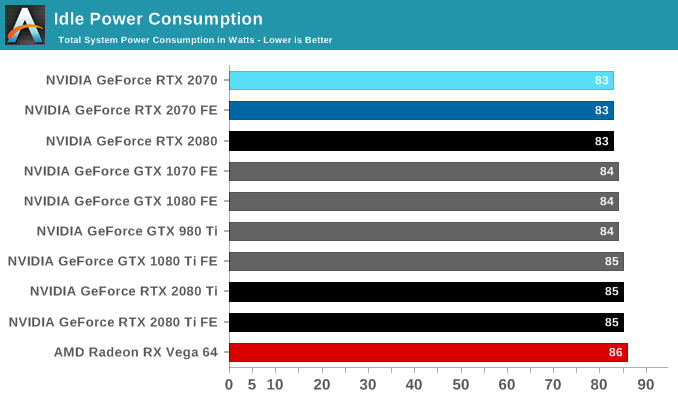
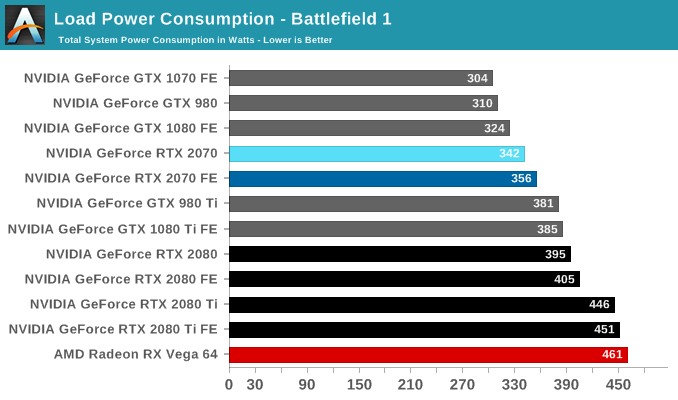
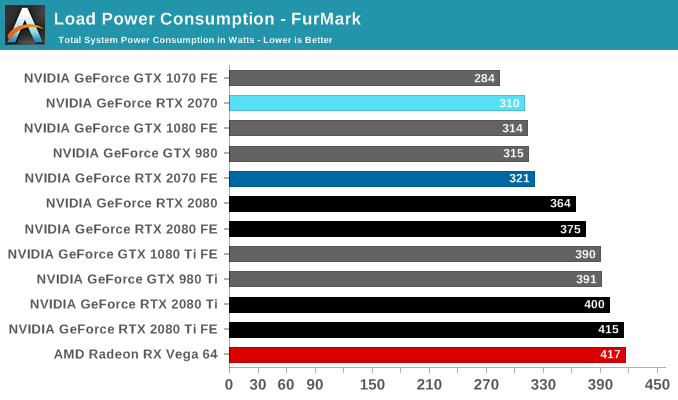
The steady TDP creep has taken its toll, and the 2070 is no longer a power-sipper of the likes of the 1070 or 970. At the very least, it is far from the excesses of its older 2080 Ti and 2080 siblings. Of note is its additional power draw over the GTX 1080, which in certain games trades blows with the 2070.
Temperature
The adoption of an open air cooler with dual axial fans has immediate benefits, especially with a lower temperature target.
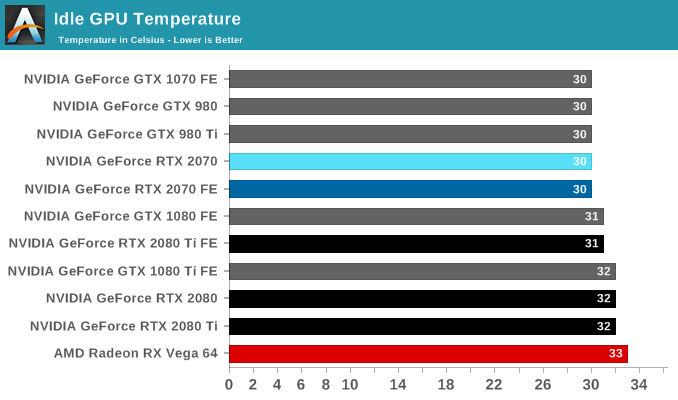
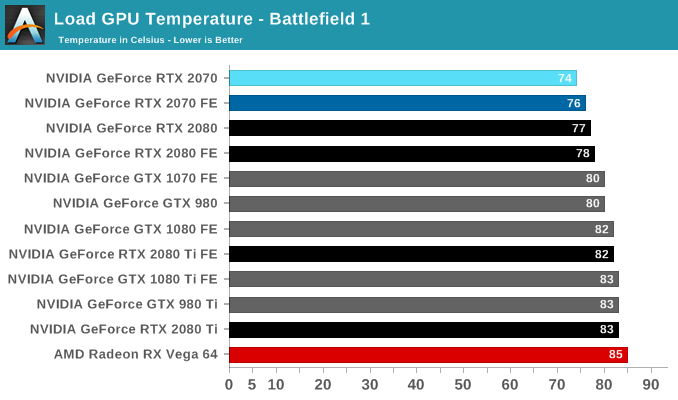
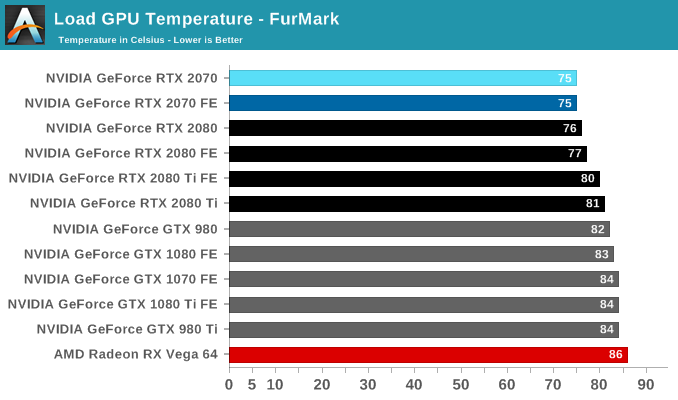
Noise
In turn, the open air cooler allows for quieter, slower spinning axial fans.

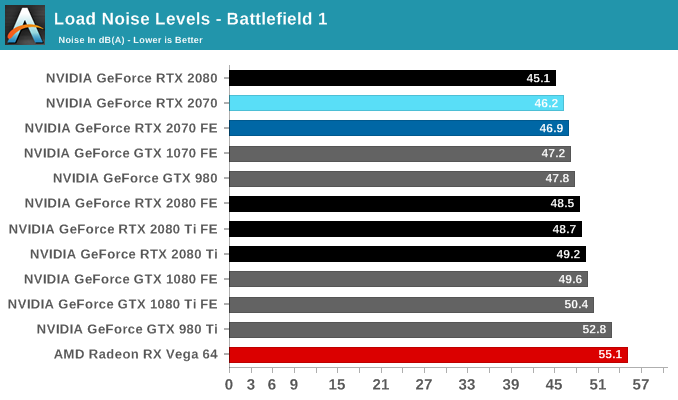
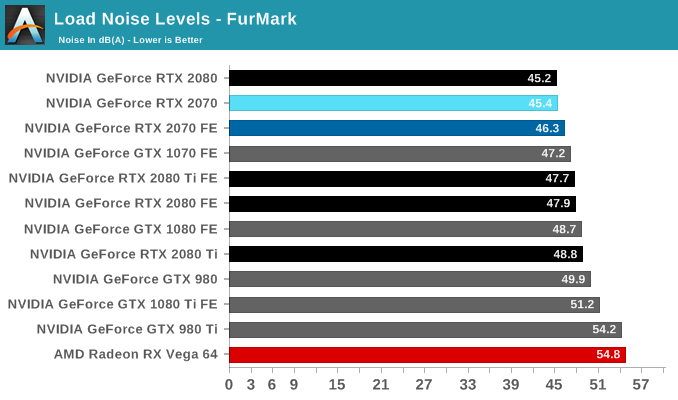










121 Comments
View All Comments
Vayra - Monday, October 22, 2018 - link
In the same vein you could say 'why get so hung up on a name to defend its a same tier card'Price matters because if perf/dollar doesn't improve there is no reason for any *buyer* to see it as a direct replacement.
Midwayman - Tuesday, October 16, 2018 - link
Why would you say that the 1080 is the card to beat and then use a garbage FE version as the benchmark comparison. Every 1080 card you're going to buy today is substantially faster than that FE version.Dr. Swag - Tuesday, October 16, 2018 - link
Because that's what they have... Plus they downclocked the founders 2070 to reference speeds too so it's not like it's that big of a deal.Midwayman - Tuesday, October 16, 2018 - link
They have tested numerous non-FE 1080 cards. The issue is that its a comparison nobody will be making when buying a 1080. It makes the 2070 look way better in the graphs than it should. If they feel the need to include a FE model for reference, fine. But they should have included a version with the faster ram and a typical factory OC since that is what is most often for sale right now. Particularly in light of the price point of the 2070.Yojimbo - Tuesday, October 16, 2018 - link
How does it make it look much better than it should when they downclocked the founder's edition to a clock below what the 3rd party 2070 cards which are comparable to the 1080s you want to use will be using.And I don't think you can use the price point of the 2070 FE or the base 2070 as a justification to include factory overclocked cards from 3rd party board partners. There are other reasons for the price differential besides price/performance in current games. And since there is a price premium for NVIDIA FE cards you're going to end up with a price comparison problem anyway.
They tested numerous non-FE 1080 cards and when they are available I'm sure they will test numerous non-FE 2070 cards. When that happens I am sure they will make the comparisons among those two sets of cards, since there will no longer be the FE/non-FE problem.
Yojimbo - Tuesday, October 16, 2018 - link
It's a difficult situation because there seems to be a dollar value to the founder's edition beyond the performance, and the reviewed card is a founder's edition.Ryan Smith - Tuesday, October 16, 2018 - link
Our editorial policy long has been (and remains) that we'll always compare products stock to stock. That means comparing a reference clocked 1070 to a reference clocked 2070, etc. This is so that we never overstate the performance of a product; as we use the reference specs, anything you buy will be as fast as our card, if not faster. As we can only loo at a finite number of cards, it continues to be the fairest and most consistent way to test cards.Plus we got a earful (rightfully) whenever we've deviated from this. You guys have made it very clear that you don't like seeing factory overclocked cards treated as any kind of baseline in a launch article.
Exodite - Tuesday, October 16, 2018 - link
Thank you Ryan!I, for one, appreciate this approach and I'm very glad to see Anandtech sticking to it.
Eletriarnation - Tuesday, October 16, 2018 - link
Pretty sure there's a mistake in the chart on the front page that puts the transistor count of the 2070 as >2x the 2080.cwolf78 - Tuesday, October 16, 2018 - link
My first PC was a Tandy 1000 RL with an Intel 8086 CPU. The first PC I ever built was a 486SX/25 and I've been a PC gamer ever since. For the first time since, well, ever, I'm seriously considering just forgoing PC gaming in the short-term. Between the ridiculous pricing of GPU's and RAM, I just don't see how this can be a hobby for the vast majority of people anymore. It's nice that you can get a lot of bang for your CPU buck these days, that doesn't even begin to make up for how much you have to bend over for the rest of it. I think I'll be getting a PS5 and call it a day and use my current PC with its OC GTX 970 for any PC exclusives I may want to play. I just can't justify spending these kind of prices. Nvidia is going to kill PC gaming for a lot of people. I'm not sure what their strategy is except to bend people over for as long and hard as they can and only then start dropping prices one sales start taking a hit. Well, sorry, Nvidia. You need to find someone else to take advantage of.